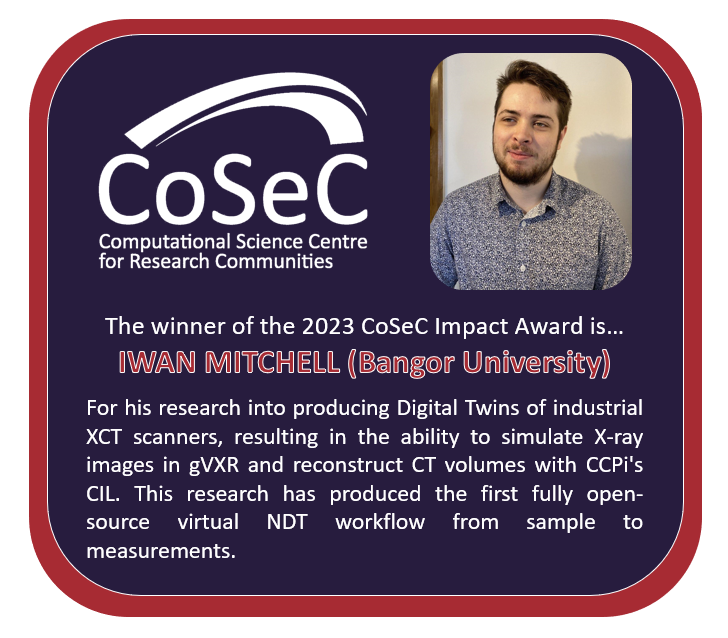We are delighted to announce that Iwan Mitchell (Bangor University) is the winner of the 2023 CoSeC Impact Award

Overview of the Research
X-ray Computed Tomography (XCT) produces 3D images of the interior of objects without damage. To "reconstruct" a CT image, thousands of X-ray images must be taken. It is widely used in medicine for the diagnostics of pathologies. Similarly, XCT is used in critical industries to ensure manufactured parts have no internal defects.In the past, computerised X-ray simulation required particle simulation via Monte-Carlo methods. Although accurate, these take hours for each image, and months to simulate enough images for a tomographic reconstruction. Using a GPU-based method, gVirtualXRay (gVXR) is an open-source X-ray simulator able to create enough accurate images for a full dataset within seconds.Most reconstruction software is proprietary, making access difficult for the scientific community, especially those without X-ray scanners. CCPi's Core Imaging Library (CIL) provides an open API for many reconstruction methods, including the building blocks for cutting-edge research regarding new techniques. However, it is aimed at Python developers.I aim to recreate X-ray scanners virtually; including behaviours and defects pure physics-based simulators fail to accommodate. These Digital Twins of real scanners can be used for planning acquisitions before being on-site, providing training to users without physical samples and beamtime, and creating large datasets for defect-detecting machine learning algorithms.CIL has been essential in my work on WebCT: a user-friendly and open-source browser-based X-ray simulation and reconstruction software, to make scan planning and training on X-ray CT accessible to those without extensive Python and X-ray CT knowledge. Support and expertise from the CIL team via in-person workshops and discussions on the CIL community discord has assisted greatly with tight integration.I've been invited to a CCPi working group meeting at the STFC Harwell Campus to present WebCT and discuss the use of scan planning to save time at beamlines such as Diamond Light Source.
Impact of the Research
My research into producing Digital Twins of industrial XCT scanners has resulted in the ability to simulate X-ray images in gVXR and reconstruct CT volumes with CCPi's CIL, resulting in the first fully open-source virtual NDT workflow from sample to measurements. Due to the virtual nature of this workflow, the bar of entry into the X-ray NDT field is minimised, previously requiring very expensive hardware, and inaccessible proprietary software.A large amount of time during X-ray scanning is wasted by feasibility questions, and tweaking parameters to optimise the scan quality. For most scientists in the UK, proposals are required to get access to an X-ray facility (e.g. from NXCT or the Diamond Light Source ), and maximising data acquisition in the limited allotted time is critical.My project WebCT aims to solve this issue by providing an accessible interface while being easy to learn. Researchers can learn the basics of X-ray NDT by changing parameters such as voltage, amperage, and filtration, seeing their virtual scanner produce images in real time. This allows them to discover if their sample is unsuitable, or what resolution and imaging artefacts they will receive from a real scan. WebCT also exposes many aspects of CCPi's CIL, such as cutting-edge reconstruction regularisers, along with high-performance tomographic reconstruction.WebCT has been presented in the IBSim-4i 2022 Image-Based Simulation for Industry conference, awarded Best Poster at the Dimensional X-ray Computed Tomography 2022 conference, and presented as part of a discussion on simulation for machine learning optimisation methods at the Workshop on Korea-UK AI/ML Research in Fundamental Sciences at Sejong University, Seoul.Impact is not limited to training and feasibility questions. Current research into using Machine Learning methods to optimise manufacturing design, require very large datasets and cannot be trained without X-ray simulations. Existing methods for accurate simulations are very slow, and fail to provide the data quantity training models require.The use of Digital Twins with gVXR can produce a tomographic dataset in seconds, opening the gateway and closing the loop for Machine Learning. This has already been applied with CIL to simulate defects in surrogate nuclear fuel pellets, and has successfully identified issues in manufacturing, such as unexpected porosity and internal cracks.In addition to defect detection, and manufacturing optimisation, work is ongoing to apply Machine Learning for optimising the scanning system itself; by adjusting X-ray tube and detector parameters for a given sample to minimise imaging artefacts. This is a work in progress, however a large impact in academics and industry is expected, dramatically simplifying the pre-processing work for NDT experts. Optimising the image quality offline is becoming possible, leading to better and cheaper scans, and an improve public safety in general if the detectability of defects can be maximised in a consistent and systematic manner.
 IwanMitchell_supportingdocuments.pdf
IwanMitchell_supportingdocuments.pdf
